Xujiang Zhao
SAUP: Situation Awareness Uncertainty Propagation on LLM Agent
Dec 02, 2024



Abstract:Large language models (LLMs) integrated into multistep agent systems enable complex decision-making processes across various applications. However, their outputs often lack reliability, making uncertainty estimation crucial. Existing uncertainty estimation methods primarily focus on final-step outputs, which fail to account for cumulative uncertainty over the multistep decision-making process and the dynamic interactions between agents and their environments. To address these limitations, we propose SAUP (Situation Awareness Uncertainty Propagation), a novel framework that propagates uncertainty through each step of an LLM-based agent's reasoning process. SAUP incorporates situational awareness by assigning situational weights to each step's uncertainty during the propagation. Our method, compatible with various one-step uncertainty estimation techniques, provides a comprehensive and accurate uncertainty measure. Extensive experiments on benchmark datasets demonstrate that SAUP significantly outperforms existing state-of-the-art methods, achieving up to 20% improvement in AUROC.
Decoding Time Series with LLMs: A Multi-Agent Framework for Cross-Domain Annotation
Oct 22, 2024



Abstract:Time series data is ubiquitous across various domains, including manufacturing, finance, and healthcare. High-quality annotations are essential for effectively understanding time series and facilitating downstream tasks; however, obtaining such annotations is challenging, particularly in mission-critical domains. In this paper, we propose TESSA, a multi-agent system designed to automatically generate both general and domain-specific annotations for time series data. TESSA introduces two agents: a general annotation agent and a domain-specific annotation agent. The general agent captures common patterns and knowledge across multiple source domains, leveraging both time-series-wise and text-wise features to generate general annotations. Meanwhile, the domain-specific agent utilizes limited annotations from the target domain to learn domain-specific terminology and generate targeted annotations. Extensive experiments on multiple synthetic and real-world datasets demonstrate that TESSA effectively generates high-quality annotations, outperforming existing methods.
RIO-CPD: A Riemannian Geometric Method for Correlation-aware Online Change Point Detection
Jul 12, 2024



Abstract:The objective of change point detection is to identify abrupt changes at potentially multiple points within a data sequence. This task is particularly challenging in the online setting where various types of changes can occur, including shifts in both the marginal and joint distributions of the data. This paper tackles these challenges by sequentially tracking correlation matrices on the Riemannian geometry, where the geodesic distances accurately capture the development of correlations. We propose Rio-CPD, a non-parametric correlation-aware online change point detection framework that combines the Riemannian geometry of the manifold of symmetric positive definite matrices and the cumulative sum statistic (CUSUM) for detecting change points. Rio-CPD enhances CUSUM by computing the geodesic distance from present observations to the Fr\'echet mean of previous observations. With careful choice of metrics equipped to the Riemannian geometry, Rio-CPD is simple and computationally efficient. Experimental results on both synthetic and real-world datasets demonstrate that Rio-CPD outperforms existing methods in detection accuracy and efficiency.
Pruning as a Domain-specific LLM Extractor
May 10, 2024



Abstract:Large Language Models (LLMs) have exhibited remarkable proficiency across a wide array of NLP tasks. However, the escalation in model size also engenders substantial deployment costs. While few efforts have explored model pruning techniques to reduce the size of LLMs, they mainly center on general or task-specific weights. This leads to suboptimal performance due to lacking specificity on the target domain or generality on different tasks when applied to domain-specific challenges. This work introduces an innovative unstructured dual-pruning methodology, D-Pruner, for domain-specific compression on LLM. It extracts a compressed, domain-specific, and task-agnostic LLM by identifying LLM weights that are pivotal for general capabilities, like linguistic capability and multi-task solving, and domain-specific knowledge. More specifically, we first assess general weight importance by quantifying the error incurred upon their removal with the help of an open-domain calibration dataset. Then, we utilize this general weight importance to refine the training loss, so that it preserves generality when fitting into a specific domain. Moreover, by efficiently approximating weight importance with the refined training loss on a domain-specific calibration dataset, we obtain a pruned model emphasizing generality and specificity. Our comprehensive experiments across various tasks in healthcare and legal domains show the effectiveness of D-Pruner in domain-specific compression. Our code is available at https://github.com/psunlpgroup/D-Pruner.
Uncertainty Decomposition and Quantification for In-Context Learning of Large Language Models
Feb 15, 2024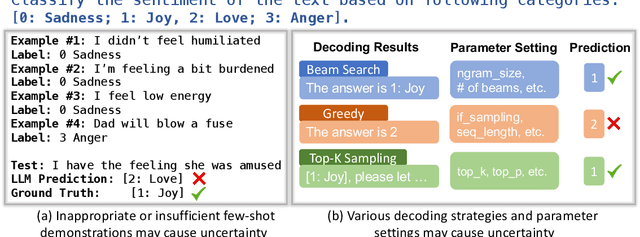
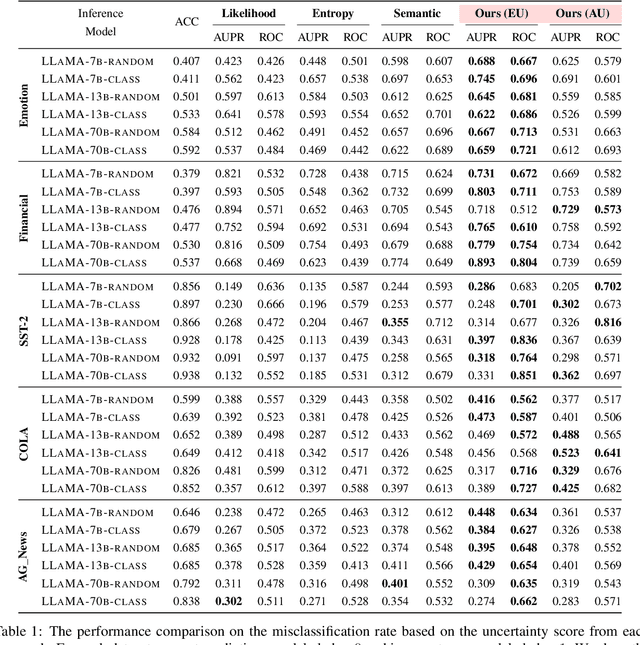
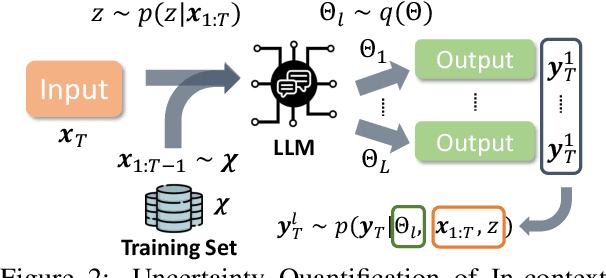
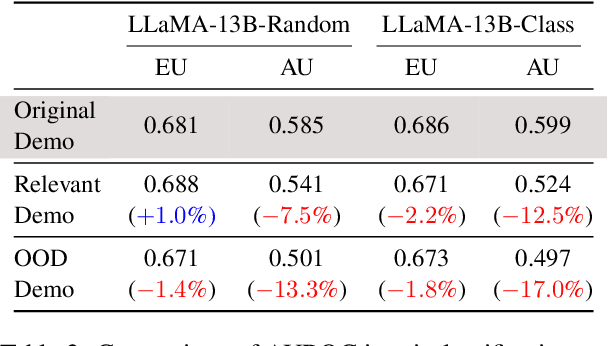
Abstract:In-context learning has emerged as a groundbreaking ability of Large Language Models (LLMs) and revolutionized various fields by providing a few task-relevant demonstrations in the prompt. However, trustworthy issues with LLM's response, such as hallucination, have also been actively discussed. Existing works have been devoted to quantifying the uncertainty in LLM's response, but they often overlook the complex nature of LLMs and the uniqueness of in-context learning. In this work, we delve into the predictive uncertainty of LLMs associated with in-context learning, highlighting that such uncertainties may stem from both the provided demonstrations (aleatoric uncertainty) and ambiguities tied to the model's configurations (epistemic uncertainty). We propose a novel formulation and corresponding estimation method to quantify both types of uncertainties. The proposed method offers an unsupervised way to understand the prediction of in-context learning in a plug-and-play fashion. Extensive experiments are conducted to demonstrate the effectiveness of the decomposition. The code and data are available at: \url{https://github.com/lingchen0331/UQ_ICL}.
Open-ended Commonsense Reasoning with Unrestricted Answer Scope
Oct 27, 2023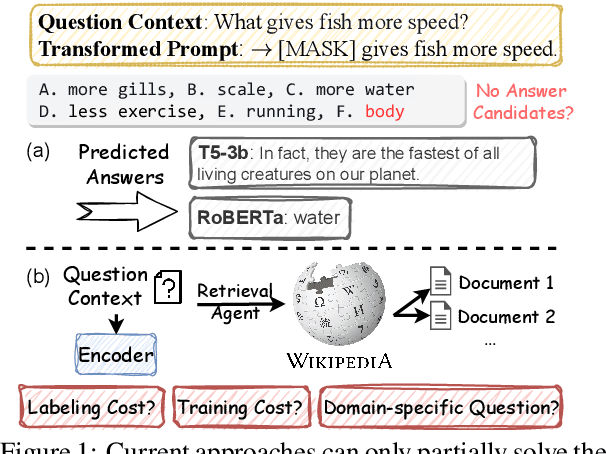
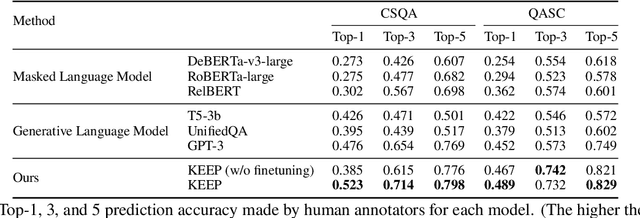
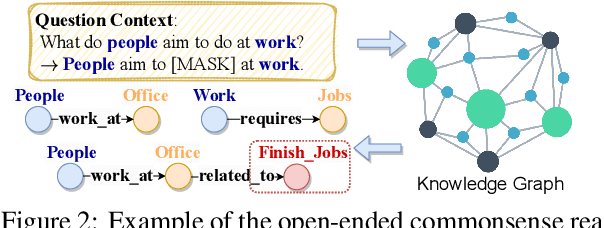
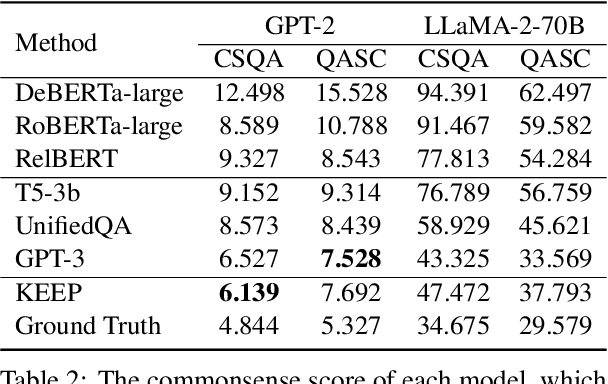
Abstract:Open-ended Commonsense Reasoning is defined as solving a commonsense question without providing 1) a short list of answer candidates and 2) a pre-defined answer scope. Conventional ways of formulating the commonsense question into a question-answering form or utilizing external knowledge to learn retrieval-based methods are less applicable in the open-ended setting due to an inherent challenge. Without pre-defining an answer scope or a few candidates, open-ended commonsense reasoning entails predicting answers by searching over an extremely large searching space. Moreover, most questions require implicit multi-hop reasoning, which presents even more challenges to our problem. In this work, we leverage pre-trained language models to iteratively retrieve reasoning paths on the external knowledge base, which does not require task-specific supervision. The reasoning paths can help to identify the most precise answer to the commonsense question. We conduct experiments on two commonsense benchmark datasets. Compared to other approaches, our proposed method achieves better performance both quantitatively and qualitatively.
Large Language Models Can Be Good Privacy Protection Learners
Oct 03, 2023Abstract:The proliferation of Large Language Models (LLMs) has driven considerable interest in fine-tuning them with domain-specific data to create specialized language models. Nevertheless, such domain-specific fine-tuning data often contains sensitive personally identifiable information (PII). Direct fine-tuning LLMs on this data without privacy protection poses a risk of leakage. To address this challenge, we introduce Privacy Protection Language Models (PPLM), a novel paradigm for fine-tuning LLMs that effectively injects domain-specific knowledge while safeguarding data privacy. Our work offers a theoretical analysis for model design and delves into various techniques such as corpus curation, penalty-based unlikelihood in training loss, and instruction-based tuning, etc. Extensive experiments across diverse datasets and scenarios demonstrate the effectiveness of our approaches. In particular, instruction tuning with both positive and negative examples, stands out as a promising method, effectively protecting private data while enhancing the model's knowledge. Our work underscores the potential for Large Language Models as robust privacy protection learners.
Pursuing Counterfactual Fairness via Sequential Autoencoder Across Domains
Sep 22, 2023Abstract:Recognizing the prevalence of domain shift as a common challenge in machine learning, various domain generalization (DG) techniques have been developed to enhance the performance of machine learning systems when dealing with out-of-distribution (OOD) data. Furthermore, in real-world scenarios, data distributions can gradually change across a sequence of sequential domains. While current methodologies primarily focus on improving model effectiveness within these new domains, they often overlook fairness issues throughout the learning process. In response, we introduce an innovative framework called Counterfactual Fairness-Aware Domain Generalization with Sequential Autoencoder (CDSAE). This approach effectively separates environmental information and sensitive attributes from the embedded representation of classification features. This concurrent separation not only greatly improves model generalization across diverse and unfamiliar domains but also effectively addresses challenges related to unfair classification. Our strategy is rooted in the principles of causal inference to tackle these dual issues. To examine the intricate relationship between semantic information, sensitive attributes, and environmental cues, we systematically categorize exogenous uncertainty factors into four latent variables: 1) semantic information influenced by sensitive attributes, 2) semantic information unaffected by sensitive attributes, 3) environmental cues influenced by sensitive attributes, and 4) environmental cues unaffected by sensitive attributes. By incorporating fairness regularization, we exclusively employ semantic information for classification purposes. Empirical validation on synthetic and real-world datasets substantiates the effectiveness of our approach, demonstrating improved accuracy levels while ensuring the preservation of fairness in the evolving landscape of continuous domains.
Improving Open Information Extraction with Large Language Models: A Study on Demonstration Uncertainty
Sep 07, 2023Abstract:Open Information Extraction (OIE) task aims at extracting structured facts from unstructured text, typically in the form of (subject, relation, object) triples. Despite the potential of large language models (LLMs) like ChatGPT as a general task solver, they lag behind state-of-the-art (supervised) methods in OIE tasks due to two key issues. First, LLMs struggle to distinguish irrelevant context from relevant relations and generate structured output due to the restrictions on fine-tuning the model. Second, LLMs generates responses autoregressively based on probability, which makes the predicted relations lack confidence. In this paper, we assess the capabilities of LLMs in improving the OIE task. Particularly, we propose various in-context learning strategies to enhance LLM's instruction-following ability and a demonstration uncertainty quantification module to enhance the confidence of the generated relations. Our experiments on three OIE benchmark datasets show that our approach holds its own against established supervised methods, both quantitatively and qualitatively.
Adaptation Speed Analysis for Fairness-aware Causal Models
Aug 31, 2023Abstract:For example, in machine translation tasks, to achieve bidirectional translation between two languages, the source corpus is often used as the target corpus, which involves the training of two models with opposite directions. The question of which one can adapt most quickly to a domain shift is of significant importance in many fields. Specifically, consider an original distribution p that changes due to an unknown intervention, resulting in a modified distribution p*. In aligning p with p*, several factors can affect the adaptation rate, including the causal dependencies between variables in p. In real-life scenarios, however, we have to consider the fairness of the training process, and it is particularly crucial to involve a sensitive variable (bias) present between a cause and an effect variable. To explore this scenario, we examine a simple structural causal model (SCM) with a cause-bias-effect structure, where variable A acts as a sensitive variable between cause (X) and effect (Y). The two models, respectively, exhibit consistent and contrary cause-effect directions in the cause-bias-effect SCM. After conducting unknown interventions on variables within the SCM, we can simulate some kinds of domain shifts for analysis. We then compare the adaptation speeds of two models across four shift scenarios. Additionally, we prove the connection between the adaptation speeds of the two models across all interventions.
 Add to Chrome
Add to Chrome Add to Firefox
Add to Firefox Add to Edge
Add to Edge